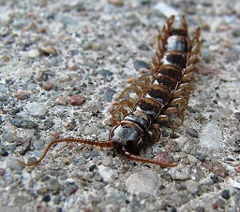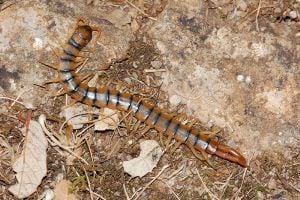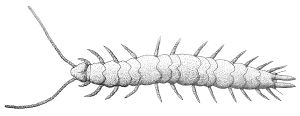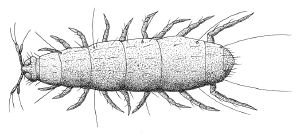Myriapoda
| Myriapoda
| ||||||
|---|---|---|---|---|---|---|
 Lithobius forficatus, a centipede
| ||||||
| Scientific classification | ||||||
| ||||||
|
Chilopoda |
Myriapoda is a subphylum of arthropods containing millipedes, centipedes, and others. The group contains 13,000 species, all of which are terrestrial [2]. Although their name suggests they have myriad (10,000) legs, myriapods range from having over 750 legs (Illacme plenipes) [3] to having fewer than ten legs. They have a single pair of antennae and simple eyes.
Myriapods are most abundant in moist forests, where they fulfill an important role in breaking down decaying plant material [2], although a few live in grasslands, semi-arid habitats or even deserts [4]. The majority are herbivorous, with the exception of centipedes, which are chiefly nocturnal predators. Pauropodans and symphylans are small, sometimes microscopic animals that resemble centipedes superficially and live in soils. Millipedes differ from the other groups in having their body segments fused into pairs, giving the appearance that each segment bears two pairs of legs, while the other three groups have a single pair of legs on each body segment.
Although not generally considered dangerous to humans, many myriapods produce noxious secretions (often containing benzoquinones) which can cause temporary blistering and discolouration of the skin [5].
The fossil record of myriapods reaches back into the late Silurian, although molecular evidence suggests a diversification in the Cambrian Period [6], and Cambrian fossils exist which resemble myriapods [2].
Classification
There has been much debate as to which arthropod group is most closely related to the Myriapoda. Under the Mandibulata hypothesis, Myriapoda is the sister taxon to Pancrustacea, a group comprising the Crustacea and Hexapoda. Under the Atelocerata hypothesis, Hexapoda is the closest, whereas under the Paradoxopoda hypothesis, Chelicerata is the closest. This last hypothesis, although supported by few, if any, morphological characters, is supported by a number of molecular studies [7].
There are four classes of extant myriapods, Chilopoda (centipedes), Diplopoda, Pauropoda and Symphyla, containing a total of around 12,000 species [8]. While each of these groups of myriapods is believed to be monophyletic, relationships among them are less certain [9].
Centipedes
Millipedes
Most millipedes are slower than centipedes, and feed on leaf litter and detritus. They are distinguished by the fusion of each pair of body segments into a single unit, giving the appearance of having two pairs of legs per segment. Around 8,000 species have been described, which may represent less than a tenth of the true global millipede diversity [8]. One species, Illacme plenipes has the greatest number of legs of any animal, with 750 [3]. Pill millipedes are much shorter, and are capable of rolling up into a ball, like pillbugs.
Symphyla
About 200 species of symphylans are known worldwide [8]. They resemble centipedes but are smaller and translucent. Many spend their lives as soil infauna, but some live arboreally. Juveniles have six pairs of legs, but, over a lifetime of several years, add an additional pair at each moult so that the adult instar has twelve pairs of legs [10].
Pauropoda
Pauropoda is another small group of small myriapods. They are typically 0.5–2.0 mm long and live in the soil on all continents except Antarctica [11]. Over 700 species have been described [8]. They are believed to be the sister group to millipedes, and have the dorsal tergites fused across pairs of segments, similar to the more complete fusion of segments seen in millipedes [12].
Arthropleuridea
Arthropleurids were ancient Myriapods that are now extinct. The most famous members are from the genus Arthropleura, which was a giant, probably herbivorous, animal that could be up to 3 meters (about ten feet) long. The Arthropleurids may be a division of the millipedes.
ReferencesISBN links support NWE through referral fees
- Integrated Taxonomic Information System (ITIS). 1999. Myriapoda ITIS Taxonomic Serial No.: 563885. Retrieved June 1, 2008.
- ↑ Myriapoda (TSN 563885). Integrated Taxonomic Information System.
- ↑ 2.0 2.1 2.2 Ben Waggoner (1996-02-21). Introduction to the Myriapoda. University of California, Berkeley.
- ↑ 3.0 3.1 Paul E. Marek & Jason E. Bond (2006-06-08). Biodiversity hotspots: rediscovery of the world's leggiest animal. Nature 441: 707.
- ↑ Myriapod. Britannica Concise Encyclopedia.
- ↑ Strange and Unusual Millipedes. herper.com. Retrieved 2007-07-02.
- ↑ Markus Friedrich & Diethard Tautz (2002). Ribosomal DNA phylogeny of the major extant arthropod classes and the evolution of myriapods. Nature 376: 165–167.
- ↑ Alexandre Hassanin (2006). Phylogeny of Arthropoda inferred from mitochondrial sequences: strategies for limiting the misleading effects of multiple changes in pattern and rates of substitution. Molecular Phylogenetics and Evolution 38: 100–116.
- ↑ 8.0 8.1 8.2 8.3 A. D. Chapman (2005). Numbers of Living Species in Australia and the World. Department of the Environment and Heritage. ISBN 0-642-56850-2.
- ↑ Jerome C. Regiera, Heather M. Wilson & Jeffrey W. Shultz (2005). Phylogenetic analysis of Myriapoda using three nuclear protein-coding genes. Molecular Phylogenetics and Evolution 34: 147–158.
- ↑ Garden Symphylans. Integrated Pest Management on Peppermint-IPMP3.0. Oregon State University. Retrieved 2007-07-02.
- ↑ Pauropods: Pauropoda. Insects and Spiders Scientific Reference. Retrieved 2007-07-02.
- ↑ David Kendall (2005-06-06). Pauropods & Symphylids. Kendall Bioresearch.
| |||||||||||||||||
Credits
New World Encyclopedia writers and editors rewrote and completed the Wikipedia article in accordance with New World Encyclopedia standards. This article abides by terms of the Creative Commons CC-by-sa 3.0 License (CC-by-sa), which may be used and disseminated with proper attribution. Credit is due under the terms of this license that can reference both the New World Encyclopedia contributors and the selfless volunteer contributors of the Wikimedia Foundation. To cite this article click here for a list of acceptable citing formats.The history of earlier contributions by wikipedians is accessible to researchers here:
The history of this article since it was imported to New World Encyclopedia:
Note: Some restrictions may apply to use of individual images which are separately licensed.



